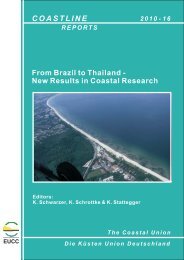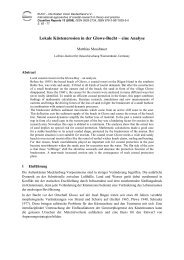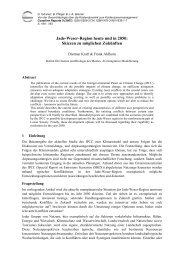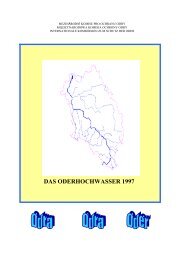An exercise in Stakeholder Analysis for a hypothetical offshore wind ...
An exercise in Stakeholder Analysis for a hypothetical offshore wind ...
An exercise in Stakeholder Analysis for a hypothetical offshore wind ...
You also want an ePaper? Increase the reach of your titles
YUMPU automatically turns print PDFs into web optimized ePapers that Google loves.
STAKEHOLDER ANALYSIS EXERCISE<br />
2.3. Assessment of <strong>Stakeholder</strong>s <strong>for</strong> importance and <strong>in</strong>fluence.<br />
In the follow<strong>in</strong>g stage of the analysis, the degree of importance or <strong>in</strong>fluence of each<br />
stakeholder with regard to the envisaged project is gauged:<br />
• A stakeholder’s degree of <strong>in</strong>fluence translates <strong>in</strong>to the relative power he or she<br />
has over the project, as well as the degree to which he or she can help desired<br />
changes to be implemented or blocked. In broad terms, a stakeholder’s <strong>in</strong>fluence<br />
derives from his or her economic, social or political position, or his or her position<br />
<strong>in</strong> the hierarchy, although it can also often be someone with contacts or personal<br />
connections with other <strong>in</strong>fluential stakeholders.<br />
Other <strong>in</strong>dicators also have to be taken <strong>in</strong>to consideration when analys<strong>in</strong>g<br />
stakeholders’ <strong>in</strong>fluence: expert knowledge, negotiat<strong>in</strong>g capacity, charisma,<br />
strategic resource control, and so on.<br />
A stakeholder’s level of importance <strong>in</strong>dicates the extent to which a project would<br />
be <strong>in</strong>effective if his or her needs and expectations were not taken <strong>in</strong>to account.<br />
These two <strong>in</strong>dicators, <strong>in</strong>fluence and importance, are not the same. In comb<strong>in</strong>ation they<br />
not only provide <strong>in</strong><strong>for</strong>mation on how stakeholders act reciprocally, but can also help to<br />
identify assumptions and risk situations <strong>for</strong> the project.<br />
These relationships can be represented <strong>in</strong> a diagram which could help to identify<br />
potential risks to the project. It also allows stakeholders with similar needs to be grouped<br />
together.<br />
A stakeholder’s <strong>in</strong>terest or <strong>in</strong>fluence can be characterised by giv<strong>in</strong>g a grade <strong>in</strong> numbers<br />
(from 0 to 10) or by giv<strong>in</strong>g High (H), Medium (M) or Low (L) rat<strong>in</strong>gs. The follow<strong>in</strong>g figure<br />
provides a sample diagram:<br />
Figure 2. Importance-Influence classification<br />
Source: Smith, Larry W., 2000<br />
S1: <strong>Stakeholder</strong> X<br />
It can be seen that <strong>in</strong> the diagram stakeholders with the highest level on both <strong>in</strong>dicators,<br />
<strong>in</strong>fluence and importance, are high-lighted aga<strong>in</strong>st a shaded background. This is<br />
because they are considered to be key stakeholders <strong>in</strong> the project. The stakeholders<br />
12








